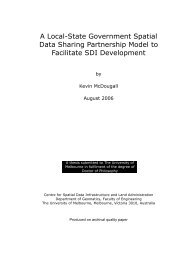Marine Cadastres - Challenges and Opportunities for Land Surveyors
Marine Cadastres - Challenges and Opportunities for Land Surveyors
Marine Cadastres - Challenges and Opportunities for Land Surveyors
You also want an ePaper? Increase the reach of your titles
YUMPU automatically turns print PDFs into web optimized ePapers that Google loves.
• To analyse Australia’s maritime boundaries <strong>and</strong> zones of maritime jurisdiction with<br />
a view to assessing claimed rights <strong>and</strong> responsibilities in the context of the<br />
evolving international law of the sea, current developments in Australian marine<br />
policy <strong>and</strong> enhanced concerns over maritime security.<br />
The new ARC brings together researchers from The University of Melbourne, The<br />
University of Wollongong <strong>and</strong> GeoFix Pty Ltd <strong>and</strong> includes four industry partners (the<br />
Australian states of Victoria, NSW <strong>and</strong> Western Australia <strong>and</strong> New Zeal<strong>and</strong>).<br />
THE LAND SURVEYORS ROLE<br />
As discussed above, a maritime nation’s rights <strong>and</strong> interests do not stop at the coastline<br />
- they extend out to the limit of the marine jurisdiction. In particular the appropriate<br />
management of the coastal zone (several kilometres inl<strong>and</strong> <strong>and</strong> several kilometres out<br />
to sea) is essential <strong>for</strong> the achievement of sustainable development objectives. Figure 1<br />
attempts to show the breadth <strong>and</strong> complexity of the relationship <strong>and</strong> impact of people to<br />
the coastal zone.<br />
On l<strong>and</strong>, the surveyor has the role of spatially defining the boundaries of the many<br />
different rights <strong>and</strong> interests that occur as part of the people to l<strong>and</strong> relationship. This is<br />
part of the l<strong>and</strong> management <strong>and</strong> l<strong>and</strong> administration processes in support of<br />
sustainable development on l<strong>and</strong>, however l<strong>and</strong> surveyors have traditionally played a<br />
limited role in this regard in the marine environment.<br />
An issue that has been discussed throughout this paper is the need <strong>for</strong> clearly defined<br />
boundaries in up to four dimensions (3D <strong>and</strong> time) to enable a better underst<strong>and</strong>ing <strong>and</strong><br />
management of the competing rights <strong>and</strong> interests in the marine environment <strong>and</strong><br />
especially the coastal zone as shown in Figure 1. Currently spatial technologies such as<br />
aerial photography, remote sensing, hydrographic surveying <strong>and</strong> GPS are being used<br />
by stakeholders in the marine environment to assess <strong>and</strong> administers rights, restrictions<br />
<strong>and</strong> responsibilities, <strong>and</strong> to try <strong>and</strong> describe the boundaries of a particular resource or<br />
location. Often these technologies are underutilised as the people from the marine<br />
sectors such as lawyers, fisheries administrators <strong>and</strong> marine biologists, have a limited<br />
spatial underst<strong>and</strong>ing or skills. Issues such as data <strong>for</strong>mats, reference frames, spatial<br />
data infrastructures <strong>and</strong> even assessing the completeness <strong>and</strong> reliability of the spatial<br />
in<strong>for</strong>mation obtained, is not fully comprehended by people from the maritime industries.<br />
There is a clear role <strong>for</strong> l<strong>and</strong> surveyors to work with the marine industries to provide<br />
better solutions to defining <strong>and</strong> managing boundaries <strong>and</strong> related spatial data in the<br />
marine environment. We are not talking about hydrographic surveying but using the<br />
skills of the cadastral surveyor in the marine environment.<br />
In many places the current l<strong>and</strong> cadastre, or l<strong>and</strong> law has extended out to include the<br />
coastline. For example in the new Vietnamese L<strong>and</strong> Law 2004, coastal <strong>and</strong> inter-tidal<br />
areas are included as l<strong>and</strong>, so that the law can be applied to these areas as they are<br />
intensely used <strong>for</strong> housing, aquaculture <strong>and</strong> salt-making. In local government areas in<br />
the State of Victoria, Australia the cadastre can extend out to 600m offshore to include<br />
jetties, marinas <strong>and</strong> other maritime infrastructure. In these cases l<strong>and</strong> surveyors have a<br />
role in defining the extent of these boundaries in terrestrial/coastal <strong>and</strong> marine areas.<br />
Much of the technology that is used in l<strong>and</strong> surveying is applicable to the marine<br />
environment. For example the accuracy <strong>and</strong> range of GPS can provide a useful solution<br />
<strong>for</strong> defining boundaries in the marine environment.







